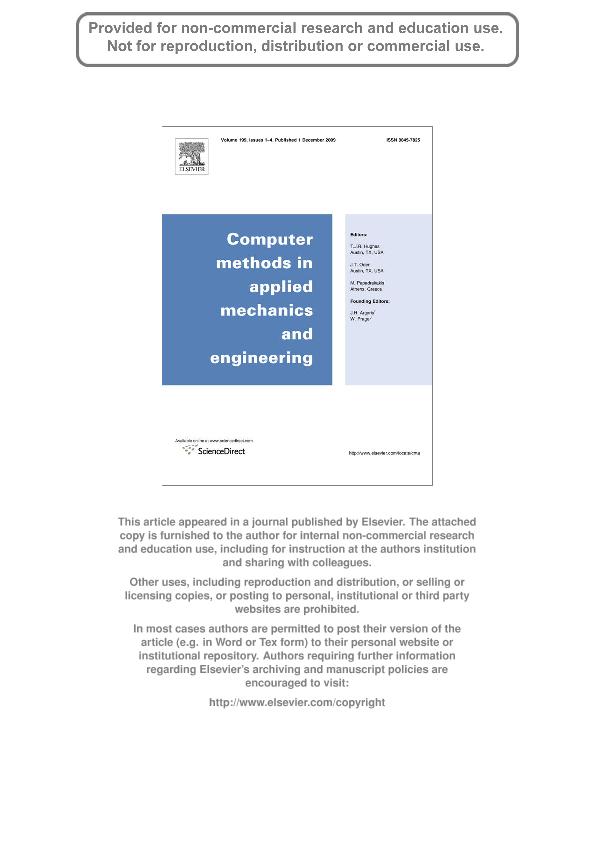Mostrar el registro sencillo del ítem
dc.contributor.author
Vrech, Sonia Mariel

dc.contributor.author
Etse, Jose Guillermo

dc.date.available
2019-04-26T21:10:08Z
dc.date.issued
2009-12
dc.identifier.citation
Vrech, Sonia Mariel; Etse, Jose Guillermo; Gradient and fracture energy-based plasticity theory for quasi-brittle materials like concrete; Elsevier Science Sa; Computer Methods in Applied Mechanics and Engineering; 199; 1-4; 12-2009; 136-147
dc.identifier.issn
0045-7825
dc.identifier.uri
http://hdl.handle.net/11336/75174
dc.description.abstract
In this work a thermodynamically consistent non-local gradient and fracture energy-based plasticity theory is proposed to simulate the failure behavior of concrete. The model incorporates two characteristic lengths, one due to the microcrack opening process and the other due to the non-local degradation process of the continuum in between cracks. The failure behavior of quasi-brittle materials like concrete is controlled by a decohesion mechanism expressed in terms of a combined fracture-energy and non-local gradient-based softening formulation. The two resulting characteristic lengths are functions of the stress state to describe the increasing non-locality of the degradation process as well as the reducing distance between microcracks with the increment of the confining pressure. In this way the transition from brittle to ductile post-peak response of quasi-brittle materials like concrete is realistically predicted. The thermodynamically consistent formulation covers both the hardening and softening regimes of the proposed constitutive model. The compressive meridian of the model maximum strength criterion agrees with that of Leon while constant and maximum value is adopted for the eccentricity leading to the circular forms of the failure surface deviatoric views similarly to the Drucker-Prager criterion. A volumetric non-associated flow rule is taken into account to appropriately describe the inelastic behavior of concrete in the low confinement regime. The predictive capabilities of the proposed constitutive formulation are tested against experimental results on concrete specimens in tensile and compressive regimes.
dc.format
application/pdf
dc.language.iso
eng
dc.publisher
Elsevier Science Sa

dc.rights
info:eu-repo/semantics/openAccess
dc.rights.uri
https://creativecommons.org/licenses/by-nc-sa/2.5/ar/
dc.subject
Fracture Energy
dc.subject
Gradient Elastoplasticity
dc.subject
Non-Local Constitutive Model
dc.subject
Quasi-Brittle Materials
dc.title
Gradient and fracture energy-based plasticity theory for quasi-brittle materials like concrete
dc.type
info:eu-repo/semantics/article
dc.type
info:ar-repo/semantics/artículo
dc.type
info:eu-repo/semantics/publishedVersion
dc.date.updated
2019-04-11T20:11:39Z
dc.journal.volume
199
dc.journal.number
1-4
dc.journal.pagination
136-147
dc.journal.pais
Países Bajos

dc.journal.ciudad
Amsterdam
dc.description.fil
Fil: Vrech, Sonia Mariel. Consejo Nacional de Investigaciones Científicas y Técnicas. Centro Científico Tecnológico Conicet - Tucumán; Argentina. Universidad Nacional de Tucumán. Facultad de Ciencias Exactas y Tecnología. Centro de Métodos Numéricos y Computacionales en Ingeniería; Argentina
dc.description.fil
Fil: Etse, Jose Guillermo. Consejo Nacional de Investigaciones Científicas y Técnicas. Centro Científico Tecnológico Conicet - Tucumán; Argentina. Universidad Nacional de Tucumán. Facultad de Ciencias Exactas y Tecnología. Centro de Métodos Numéricos y Computacionales en Ingeniería; Argentina
dc.journal.title
Computer Methods in Applied Mechanics and Engineering

dc.relation.alternativeid
info:eu-repo/semantics/altIdentifier/url/https://www.sciencedirect.com/science/article/pii/S0045782509003326
dc.relation.alternativeid
info:eu-repo/semantics/altIdentifier/doi/https://doi.org/10.1016/j.cma.2009.09.025
Archivos asociados
